What are Moroccan Preserved Lemons?
Cured lemons have long been a part of Mediterranean and Middle Eastern cooking, although most people associate them with North African, and particularly Moroccan cuisine.
Sometimes a plain squeeze of lemon juice on top of a dish is not enough, and that’s when we want to use preserved lemons. They add BIG flavor. The flavor can be described as highly citrusy, floral from the oils in the peels, and full of umami flavors from fermentation.
Preserved lemons add a fermented quality that regular lemons do not.
Are preserved lemons fermented?
You can read about all the types of salt fermentation here: The Complete Guide to Salt Fermentation
Salt curing is a specific kind of salt fermentation that uses exceptionally high salt levels to preserve ingredients.
While other salt fermentation methods usually include water, either added or from the vegetables themselves, salt curing does not.
Curing is a “dry” process. No water is added, and so much salt is added that it reduces the water activity. Foods like miso and these Moroccan preserved lemons are considered salt-cured. These foods still contain microbes, and microbes are active in these foods, but are not as microbially active as other salt fermentation methods.
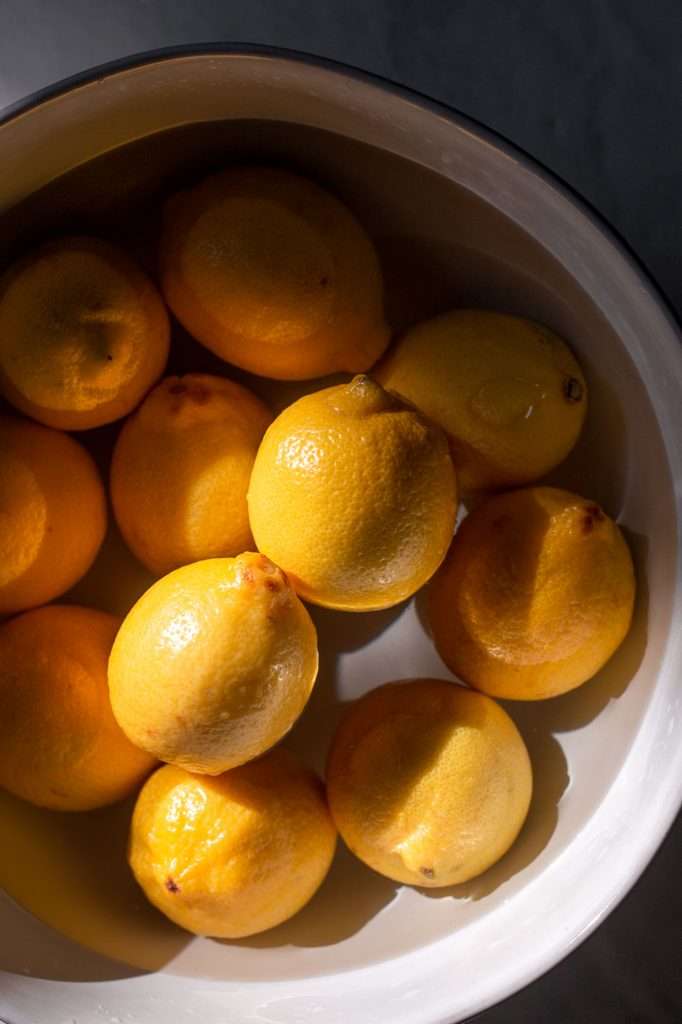
Moroccan Preserved Lemons
Long ago, as lemon trees spread from Morocco to India, so did the want and need to preserve them. Originally, lemons were preserved for the same reason all things are preserved—to store and eat them even when they are out of season.
Before refrigeration, preservation almost always happened through salting and/or fermentation. The earliest recipe for preserved lemons is recorded in the 12th-century Egyptian treatise On Lemon, Its Drinking and Use, by the Arabic-speaking court physician Ibn Jumay.
Jumay’s 900-year-old recipe is almost exactly like the preserved lemon recipes we see today. According to Toby Sonneman’s Lemon: A Global History, the recipe calls for “slitting the fruit and filling the gashes with salt, then pressing them into a jar, covering with lemon juice and letting them ferment for weeks.” In this recipe, we follow similar methods.
The hardest part of this recipe is quartering the lemons without slicing them all the way through. It helps to cut the ends off the lemons so you can stand them flat on a cutting board to quarter them.
You want the quarters to stay attached on one end so that the lemons kind of open up like a flower to hold the salt.
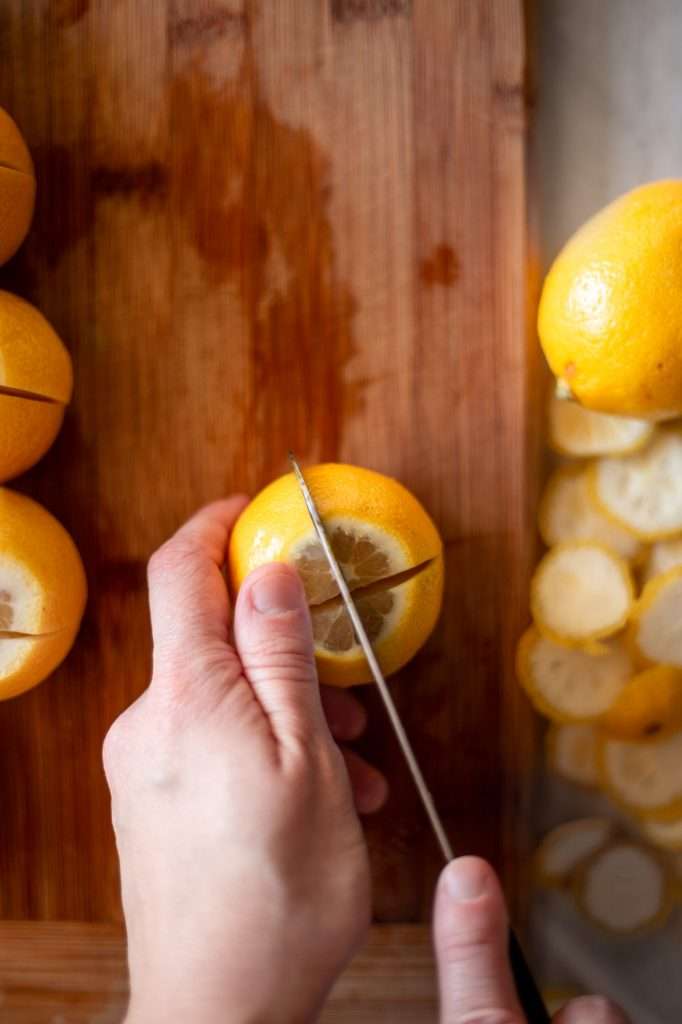
Recipes with Preserved Lemons
This is the traditional historical recipe I’ve based mine off of… except I use weight measurements for consistency. Limes and grapefruits can also be preserved the same way, leading to all kinds of fun fermentation experiments and recipes this summer.
I plan to let mine ferment for a month; then they will keep in the fridge indefinitely. I’ll probably use them in salads and light, fresh meals on hot days this summer. I’d love to develop a Mediterranean lamb burger recipe that calls for preserved lemons.
To use these fermented lemons, you can chop and use them as is for a source of lemon flavor and salt, or you can rinse the lemons. I mostly discard the pulp, then rinse the rind well to chop and use anywhere I’d use lemon zest.
It doesn’t take much fermented lemon to add a delicious bright lemon flavor to recipes.
Click here to try my shrimp ceviche recipe with fermented lemon.
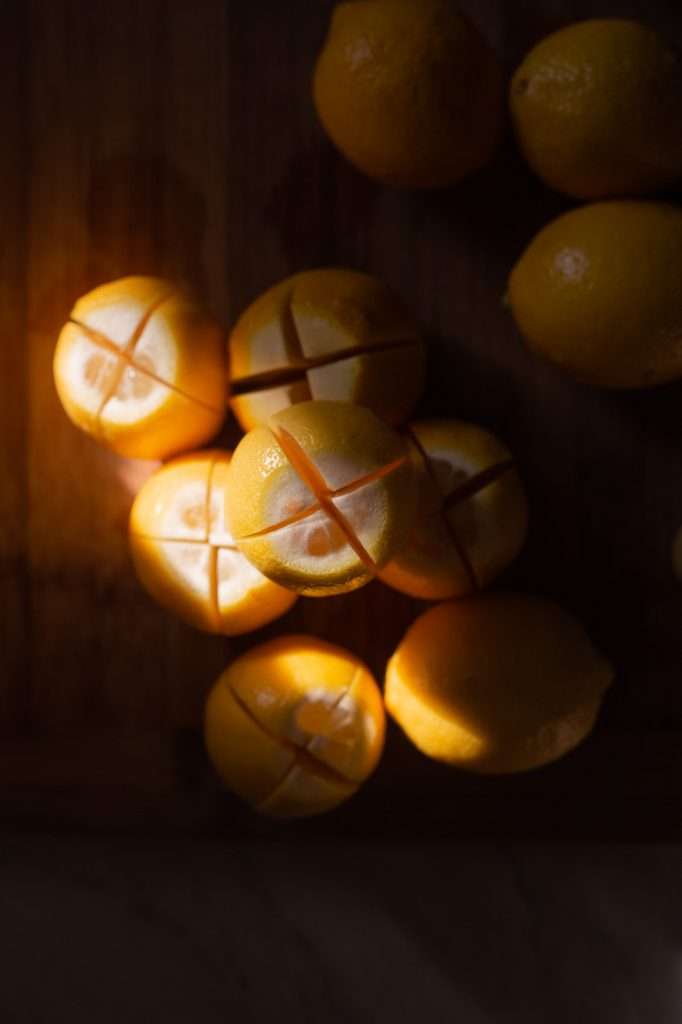

Preserved Lemon Recipe
Here are the supplies you need:
- 32 ounce Wide Mouth Mason Jar
- Standard Metal Mason Jar Lid (this can rust in the presence of salt)
- OR Rust Free Plastic Lid
- or you can use a Weck Jar (without the gasket; only use the clips to secure the lid)
- Sea Salt
- Scale
- Mixing Bowl
Fermented Lemons
Here are the fermentation conditions for these lemons:
- 20% Salt
- 4 weeks of fermentation
- 60-80°F
- Final pH about 3
- Store in the refrigerator indefinitely; these lemons also keep at room temperature for a year.

What to Make with Fermented Lemons
- Black Mussels in Fermented Lemon Butter Broth
- Mango Shrimp Ceviche with Fermented Lemon
- Smoked Salmon Carpaccio with Miso and Crispy Fermented Lemon
- Homemade Cultured Butter with Lemon and Herbs
- Sourdough Lemon Blueberry Cookies (Blueberry Muffin Cookies)


How to Make Moroccan Preserved Lemons with Sea Salt
Moroccan preserved lemons are so easy to make! This is the best way to preserve lemons, and the whole lemon is used. You only need two ingredients, lemons and sea salt. This recipe takes about 10 minutes to prep and four weeks of fermentation time.
- Prep: 10 minutes
- Total Time: 672 hours 10 minutes
Ingredients
- 1300 grams fresh lemons (about 8 to 10 small lemons)
- 200–250 grams sea salt
- 2 extra lemons for juicing (if needed)
Instructions
- Wash all of the lemons, and weigh out the salt in a bowl
- Cut the ends off the lemons, then starting at one end, cut each lemon into quarters, without cutting all the way through (see photos above).
- Over a large bowl, fill the crevices of the lemons with copious amounts of salt. Fill each lemon with salt until all the salt is used up.
- Start packing the whole lemons into a clean, large jar. A quart mason jar worked well for me, but depending on the type of lemon you use, you may need a bigger jar. You will have to wedge them in as tightly as possible, and lemon juice will be released in the process.
- Once the jar is full make sure all the lemons are submerged in lemon juice. If you need to, juice two lemons and add the juice to the jar.
- Place a lid on the jar and allow the lemons to cure at room temperature for 4 weeks. You can allow the lemons to cure for up to a year at room temperature. They will darken the longer they cure.
- Once opened, store in the fridge indefinitely. Rinse off any excess salt and brine before using the preserved lemons in recipes. You can discard the pulp and use the well-rinsed rind anywhere that you’d use lemon zest.





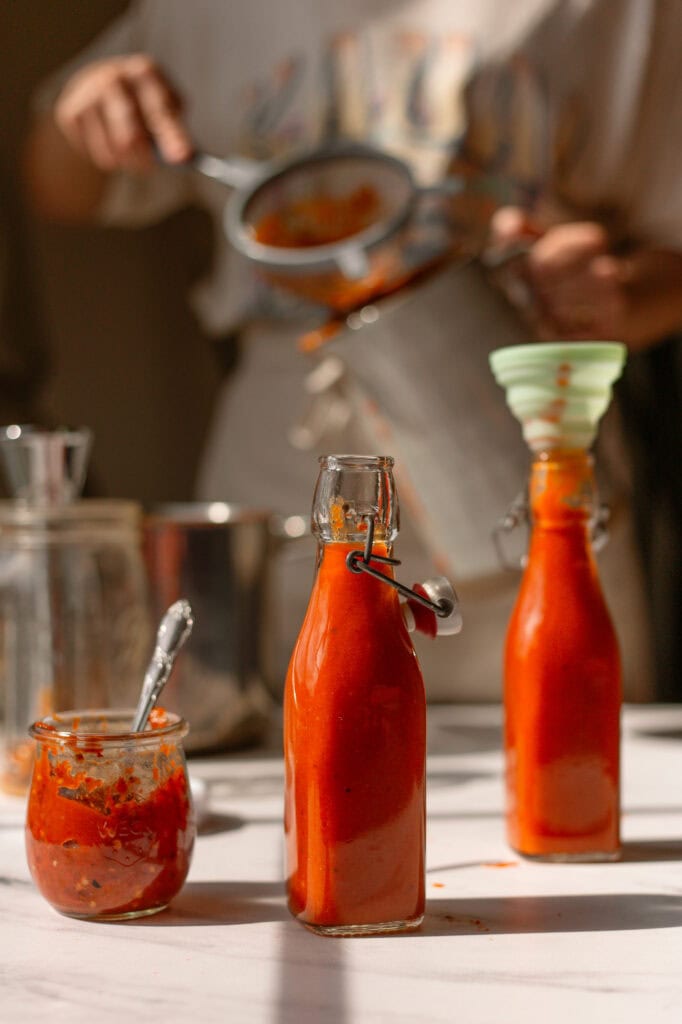





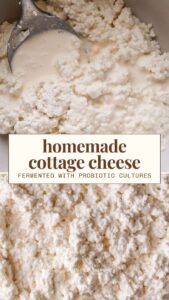
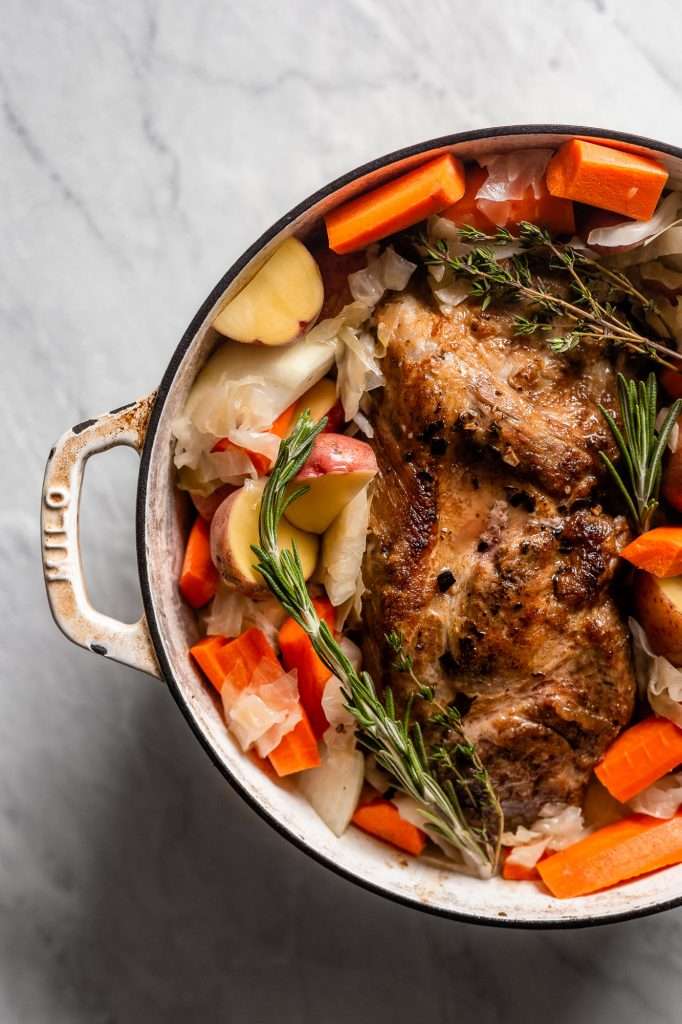
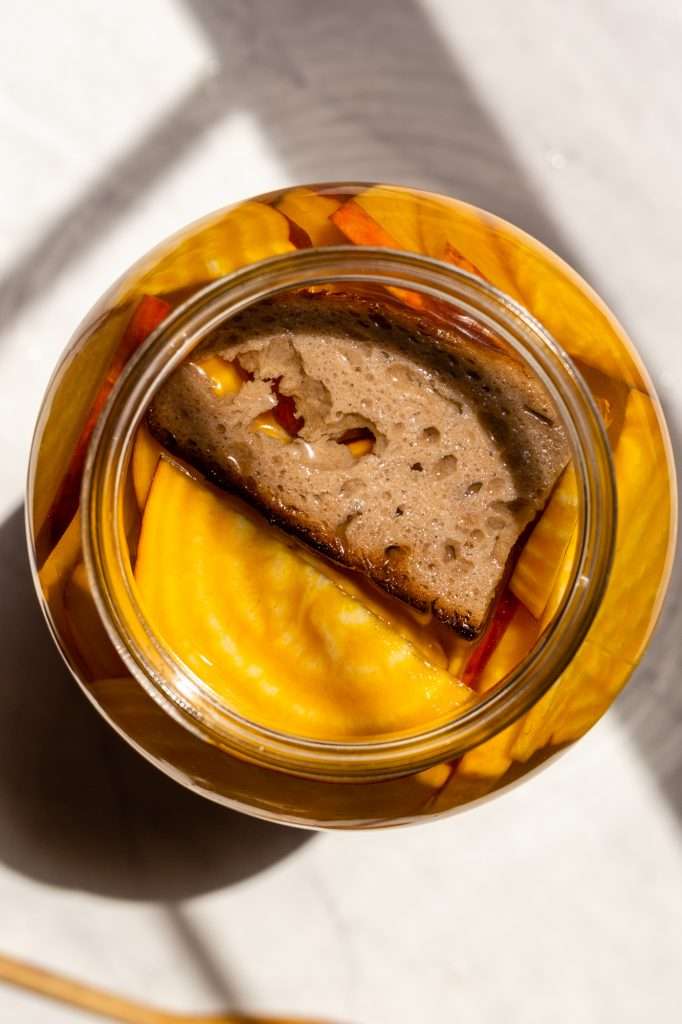
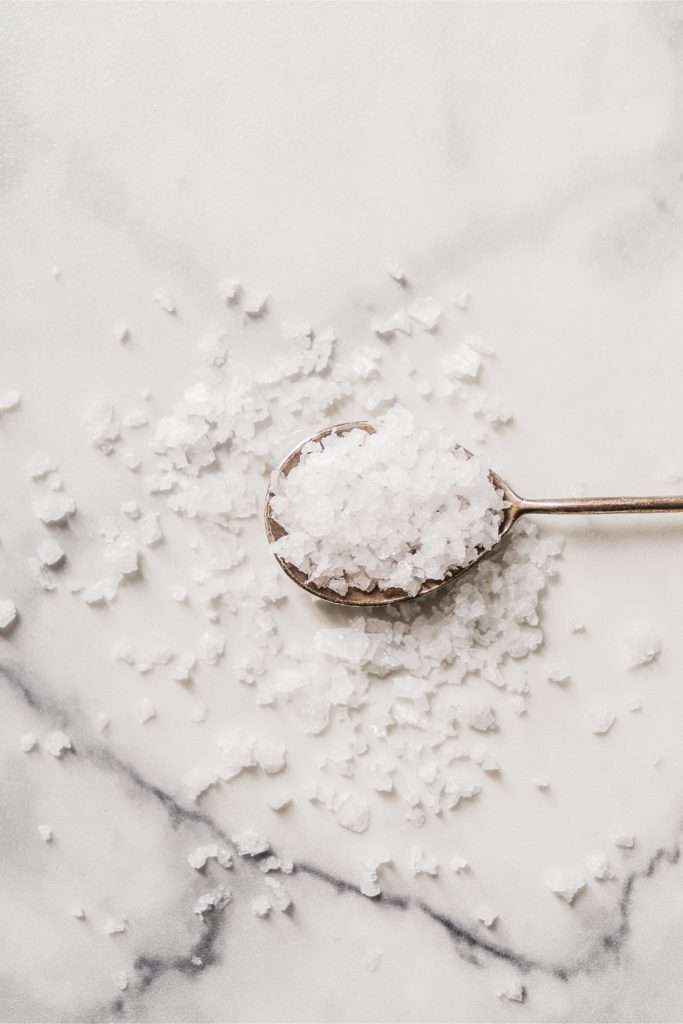



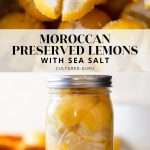
When I was a kid my grandfather used to put salt on a lemon slice and eat it just like that. He taught me to do the same and it’s one of the most delicious things, and one of my fondest memories. I’ve never heard of preserved lemons before until Dec 2021 on our honeymoon trip and imagine my surprise when I found this recipe. This recipe is extremely easy to make and it’s absolutely delicious. Sometimes I’ll eat just a slice by itself because it’s just that good or when I’m feeling different I’ll chop up the pieces and put it in a salad. It’s refreshing and it adds that bit of acidity to a dish that you’re looking for. Try it! Cultured Guru coming through with the amazing recipes!
Can you use kosher salt instead of sea salt?
yes! any salt will work
I followed the directions but have a lot of salt left in the big bowl. Is that expected?
it’s fine!
Can I use oranges?
OK, I have done and weighed the lemons – I have 12 average size lemons. There is no way I could put them in a 32 oz jar. The juice alone was at the top so I had to put the rest of the lemons in another smaller jar.
That’s fine.
Some questions! I made this yesterday- I put all the extra salt in the jar. Added the juice of 2 extra lemons and everything was submerged. Today woke up and noticed the lemons floating up so the top few are no longer submerged. Do I open the jar and mash them down? Did I not add enough liquid?
It sounds like you have enough liquid if things are floating. My jar pictured here was so full and packed that nothing could float. You can open the jar and smash them down.
Hi! A question about the Weck jar. Why should we not use the rubber seal?
Thank you!!
I usually don’t use the rubber seal when fermenting in weck jars to let gas escape naturally. But in this case it doesn’t matter because there wont be any bubbles in this type of fermentation.You can use the seal if you’d like.
I use the pulp in baking!
Help! I made a big, beautiful jar of these lemons and I have been watching and waiting for the last few weeks… today I took the lid off and I noticed that some of the seeds and a part of a lemon floated to the top and there are lots of black, brown moldy spots and a few yellowish, greenish fuzzy spots on the seeds and lemons above the lemon juice and also on the side of the jar and lid. Is the entire jar ruined or can I just remove the spoiled pieces, clean off the jar and leave the rest to finish fermenting? Should I clean it all off now or after it finishes fermenting?
hmmmm… Did you by chance reduce the salt in the recipe? or use a silicone lid? There is so much salt in this recipe it should prevent that. Usually the brine is so thick from all the salt that nothing really “floats”. If there is mold, it’s an eat at your own risk situation.
My first time to prep fermented lemon 4/28/24.
I will send update in 4 weeks. Thanks for sharing this recipe.
All I have to say is MAKE THESE. They are incredible, I use lemons or limes, I especially enjoy using the limes off of my tree since my lemons have thick rinds. Similar flavor either way but sometimes the lemons end up a bit more bitter (again, I think it is because my lemons have a thick rind with a lot of the white pith). Incredible to make into a pasta sauce, marinade tofu, salad dressing, avocado toast, etc. but remember they are very salty (in a good way) so avoid adding any salt if you’re cooking with these. Also I like to purée the whole jar once it is completed to just easily scoop to use in recipes. 10/10
I did my lemons yesterday and am concerned I may not have used as much salt as needed. Can I just pour some salt into the liquid?
Also is there anything you can do with the liquid at the end or just pour away?
you can add more salt. The liquid in mine is more like a syrup since there is so much salt. I just keep them lemons in it, and when I use the lemons I rinse them off first.
Love these so much! I will keep a steady supply of these on hand from now on. I made a jar of lemons and a jar of limes. The limes were more difficult because they were so much drier and hard to get enough juice, but they taste amazing. I think from now on I will mix some lemons and limes together to get the lime flavor, but make the juice situation easier. These were worth the month-long wait. I use them on so many things, but even enjoy them (in small portions) straight. They have such a nice texture. Great on top of ramen! Thank you for the amazing recipe!
I’m getting ready to make these right now. Is a glass fermenting weight necessary?
I don’t list to use one in the instructions.
I have been using this recipe for 10 years. The lemons are very tasty in soup, Mexican rice, and other dishes. Thank you for writing down the recipe.